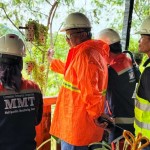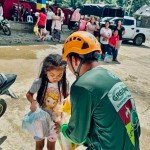-
A green legacy. Aside from planting and growing over 380 thousand trees in Canatuan, TVIRD establishes environment-oriented livelihood programs in order to sustain both Muslim and Subanon communities beyond the life of its mine.
-
Leaving a “greener” Canatuan: Tree planting at the minesite. TVIRD, like the rest of the member companies of the Chamber of Mines of the Philippines, is a prolific re-forester.
Earmarks Php113 million for its mine rehabilitation fund
Siocon, Zamboanga del Norte / August 2013 – Set to conclude its operations at the end of year, TVI Resource Development Philippines Inc. (TVIRD) recently established a five-hectare mangrove and bamboo plantation across three barangays in Siocon, Zamboanga del Norte on top of its current reforestation and sustainable development programs that will be sustained long after the life of the mine. This effort is in line with the government’s National Greening Program (NGP), which has planted over 19 million seedlings as of 2012, and the commitment of the Chamber of Mines of the Philippines member-companies to plant 25 million more seedlings across 300 thousand hectares in the current year. This brings the cumulative total area to 1.5 million hectares over a six-year period.
Environmental management and sustainable livelihood
TVIRD Environment Manager Nilda Callora said that the main sources of livelihood of Barangays Matiag, Tibangao and Makiang are aquaculture and fishing. She added that in the years to come, the development of mangrove and bamboo plantations will ensure the place’s rich bio-diversity and continued sustainability, especially for the Muslim community that comprises the barangays’ majority.
In Siocon’s hinterlands meanwhile, the company reported its NGP contribution to the Department of Environment and Natural Resources (DENR) intended for the benefit of its indigenous Subanon hosts.
“A total of 95 thousand rubber seedlings and 4 thousand fruit tree seedlings have been planted in 190 hectares since 2009 in favor of 238 Subanon families, representing 86 percent of the company’s total household target,” according to Community Relations Manager Joel Alasco.
“These rubber trees not only add as forest cover, but more importantly, these will provide significant and stable income for the Subanons’ sustainable livelihood in a few years time,” Alasco added.
A rubber seedling takes an average of five years to produce commercially-viable rubber latex. One hectare of rubber trees will generate an estimated Php15 thousand monthly income to the beneficiaries. This further strengthens the Zamboanga Peninsula’s position as the country’s top rubber producer.
Final mine rehabilitation
TVIRD’s copper-zinc mine in the Subanon ancestral domain in Canatuan is scheduled to decommission its current mining operations due to ore depletion after operating for nearly 10 years. As the company officially marks the end of its mine life, it simultaneously commences its final rehabilitation stage.
To date, TVIRD has planted and grown over 380 thousand trees as part of its progressive rehabilitation program. This includes previously mined-out areas, overburden stockpile areas and the tailings impoundment areas. Previously revegetated areas are now interplanted with endemic species.
The planted trees are of different varieties, particularly hardwoods of endangered species like Acacia, Mangium, White and Red Lauaan, Palo Negro, Lumbayao, Narek, Salao, Gibo, among many others.
Over Php100 million has been committed for post mining reclamation, in addition to annual progressive rehabilitation programs, added Callora.
Subsequent to its ongoing progressive rehabilitation program, there will be a two-year active rehabilitation and decommissioning program after TVIRD concludes its mining operations. This will be followed by a three-year passive rehabilitation program to monitor and enhance the initial two-year activities and a potential five more years to serve as the final evaluation period.
The final reclamation and closure will be incorporated into the overall long-term sustainable development program for the Subanons.
Download PDF
Download Word Document





